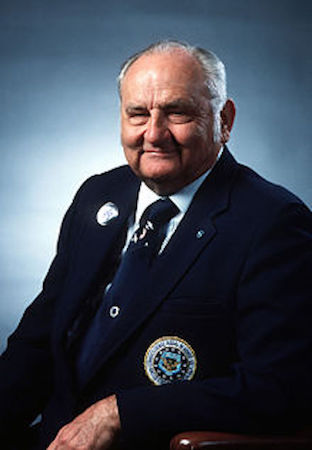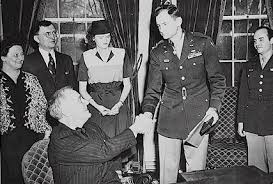Edward S. Michael
Edward Stanley Michael was a United States Army Air Force officer and was awarded the Medal of Honor, the United States military’s highest decoration.
Michael was born on May 2, 1918, in Chicago, Illinois. He joined the Army Air Corps in Chicago, in November 1940. In 1941, he was transferred to Wheeler Field in Hawaii to train as a mechanic. He had failed his first aviation cadet examination and was preparing to retake it when the Japanese attacked Pearl Harbor on December 7, 1941. In 1942, he was accepted for pilot training and on April 12, 1943, he received his commission and his pilot wings at Douglas Army Air Field in Arizona.
On April 11, 1944, as pilot of a B-17 Flying Fortress with the 364th Bomb Squadron, he was flying a mission over Germany. His aircraft was singled out by enemy fighters and severely damaged by cannon fire. As flames burned in the plane’s bomb bay, Maichael, who had been seriously wounded, ordered his crew to bail out. Upon finding one of his crewmen’s parachute was unusable, Michael returned to the controls and managed to evade the enemy fighters and heavy anti-aircraft fire to fly his bomber into Allied territory. He successfully crash landed on English soil. All of the seven crew members who escaped were captured by the German forces and held as prisoners of war. He was awarded the Medal of Honor nine months later on January 15, 1945. He returned to the U.S. for hospitalization.
After the war was over, he transferred to the newly created U.S. Air Force and served at Fort Totten in Washington, DC. He graduated from Air University in April 1949 and for the next three years was a pilot at Hill Air Force Base in Utah. In September 1952, he was assigned to first Guam and then to Hickam Field in Hawaii. After he returned to the continental United States in June 1955, he served in various positions at Fort Douglas (Utah), McConnell AFB (Kansas), Travis AFB (California).
He was promoted to lieutenant colonel on August 1, 1963, and retired in 1971. He joined The Church of Jesus Christ of Latter-day Saints in 1976.
Michael died on May 10, 1994.
Michael's official Medal of Honor citation reads:
- For conspicuous gallantry and intrepidity above and beyond the call of duty while serving as pilot of a B17 aircraft on a heavy-bombardment mission to Germany, April 11, 1944. The group in which 1st Lt. Michael was flying was attacked by a swarm of fighters. His plane was singled out and the fighters pressed their attacks home recklessly, completely disregarding the Allied fighter escort and their own intense flak. His plane was riddled from nose to tail with exploding cannon shells and knocked out of formation, with a large number of fighters following it down, blasting it with cannon fire as it descended. A cannon shell exploded in the cockpit, wounded the copilot, wrecked the instruments, and blew out the side window. 1st Lt. Michael was seriously and painfully wounded in the right thigh. Hydraulic fuel filmed over the windshield making visibility impossible, and smoke filled the cockpit. The controls failed to respond and 3,000 feet were lost before he succeeded in leveling off. The radio operator informed him that the whole bomb bay was in flames as a result of the explosion of 3 cannon shells, which had ignited the incendiaries. With a full load of incendiaries in the bomb bay and a considerable gas load in the tanks, the danger of fire enveloping the plane and the tanks exploding seemed imminent. When the emergency release lever failed to function, 1st Lt. Michael at once gave the order to bail out and 7 of the crew left the plane. Seeing the bombadier firing the navigator's gun at the enemy planes, 1st Lt. Michael ordered him to bail out as the plane was liable to explode any minute. When the bombardier looked for his parachute he found that it had been riddled with 20mm fragments and was useless. 1st Lt. Michael, seeing the ruined parachute, realized that if the plane was abandoned the bombardier would perish and decided that the only chance would be a crash landing. Completely disregarding his own painful and profusely bleeding wounds, but thinking only of the safety of the remaining crewmembers, he gallantly evaded the enemy, using violent evasive action despite the battered condition of his plane. After the plane had been under sustained enemy attack for fully 45 minutes, 1st Lt. Michael finally lost the persistent fighters in a cloud bank. Upon emerging, an accurate barrage of flak caused him to come down to treetop level where flak towers poured a continuous rain of fire on the plane. He continued into France, realizing that at any moment a crash landing might have to be attempted, but trying to get as far as possible to increase the escape possibilities if a safe landing could be achieved. 1st Lt. Michael flew the plane until he became exhausted from the loss of blood, which had formed on the floor in pools, and he lost consciousness. The copilot succeeded in reaching England and sighted an RAF field near the coast. 1st Lt. Michael finally regained consciousness and insisted upon taking over the controls to land the plane. The undercarriage was useless; the bomb bay doors were jammed open; the hydraulic system and altimeter were shot out. In addition, there was no airspeed indicator, the ball turret was jammed with the guns pointing downward, and the flaps would not respond. Despite these apparently insurmountable obstacles, he landed the plane without mishap.

